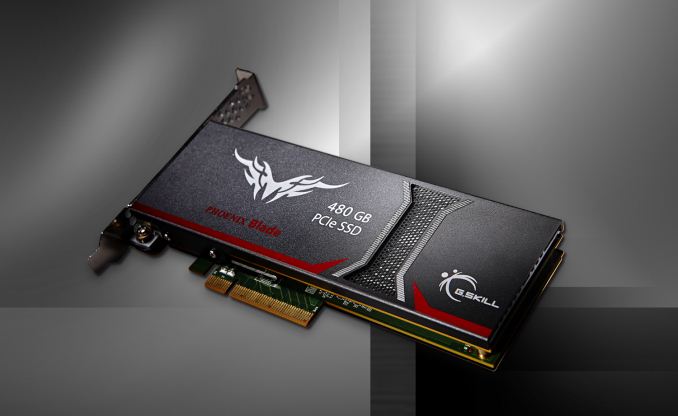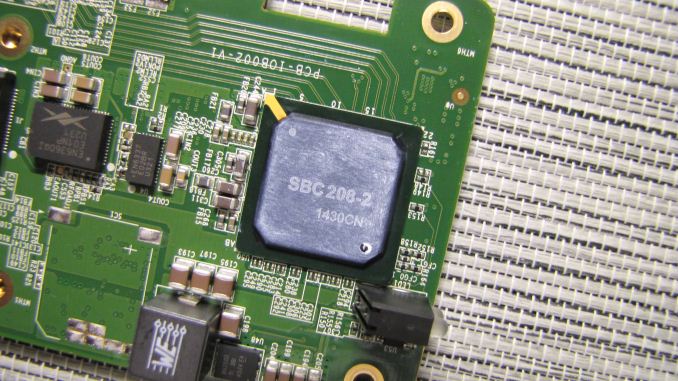G.Skill Phoenix Blade (480GB) PCIe SSD Review
by Kristian Vättö on December 12, 2014 9:02 AM EST
G.Skill hasn't been a very visible SSD OEM lately. Like many DRAM module companies, G.Skill entered the market early around 2009 when the market was very immature and profits were high, but lately the company has more or less been on a hiatus from the market. Even though G.Skill has had an SF-2281 based Phoenix III in the lineup for quite some time, it never really did anything to push the product and a Google search yields zero reviews for that drive (at least from any major tech review outlet).
However, back at Computex this year G.Skill showcased a prototype of its next generation SSD: the Phoenix Blade. Unlike most SSDs on the market, the Phoenix Blade utilizes a PCIe 2.0 x8 interface, but unfortunately it is not the native PCIe drive many of you have been waiting for. It is driven by four SandForce SF-2282 controllers in a RAID 0 configuration. It makes sense for G.Skill to pursue the ultra high-end niche because the SATA SSD market is currently extremely populated. It ends up being close to impossible for the smaller OEMs to compete against giants like Samsung, SanDisk and Crucial/Micron while being profitable, since ultimately the NAND manufacturers that are vertically integrated will always have a cost advantage.
| G.Skill Phoenix Blade Specifications | |
| Capacity | 480GB |
| Form Factor | Half-Height, Half-Length (HHHL) |
| Interface | PCI Express 2.0 x8 |
| RAID Controller | SBC 208-2 |
| NAND Controller | 4x SandForce SF-2282 |
| NAND | Toshiba 64Gbit 19nm MLC |
| Sequential Read | Up to 2000MB/s |
| Sequential Write | Up to 2000MB/s |
| 4KB Random Read | Up to 90K IOPS |
| 4KB Random Write | Up to 245K IOPS |
| Power Consumption | 8W (idle) / 18W (max) |
| Encryption | AES-128 |
| Endurance | 1536TB (~1.4TB per day) |
| Warranty | Three years |
At this moment the Phoenix Blade is only available in 480GB capacity, although G.Skill plans to add a 960GB model later. 480GB is a logical choice because for the target group 240GB would be too small in many cases and doesn't provide the same level of performance, whereas the cost of the 960GB would push most shoppers away. In the end, G.Skill hasn't been actively involved in SSDs recently, so doing a 'soft' launch and observing the market's reaction is a safe strategy.
The interesting spec is the endurance and it's not a typo. G.Skill is indeed rating the Phoenix Blade at 1,536TB, which translates to 1.4TB (i.e. 1433.6GB) of writes per day for three years. I asked G.Skill about the rating method and I was told it's simply raw NAND capacity multiplied by the number of P/E cycles, which is then divided by the average write amplification. G.Skill assumes an average write amplification of 1x due to SandForce's real-time data compression, so 512GB*3,000/1 yields 1,536TB. As G.Skill's SSD venture is solely consumer focused, it has no reason to artificially limit the endurance to boost its enterprise SSD sales like many vendors do, although I am concerned whether the Phoenix Blade has been fully validated for workloads that write over a terabyte of data per day.
Delving into the Phoenix Blade reveals a massive metal heatsink that covers nearly the whole PCB (or both PCBs, actually). There's plenty to cool since each SF-2282 can draw up to ~4W under load plus at least another couple of watts for the RAID controller, which results in a maximum power rating of 18W according to G.Skill's data sheet.
Taking off the heatsinks reveals the main PCB as well as the daughterboard. Both are home to two SF-2282 controllers with each controller being connected to eight dual-die 16GB NAND packages (i.e. 32*16GiB=512GiB of NAND in total).
The RAID controller in the Phoenix Blade is a complete mystery. Googling the part number doesn't bring any light to the situation and due to confidentiality agreements G.Skill is tightlipped about any details regarding the controller. My best guess is that the controller features firmware from SBC Designs with the actual silicon coming from another vendor.
Update 12/13: It turns out that the controller has actually nothing to do with SBC Designs as it's from Comay that is a brand used by CoreRise, which is a Chinese SSD manufacturer. In fact, the Phoenix Blade looks a lot like CoreRise's Comay BladeDrive G24, so I wouldn't be surprised if G.Skill was sourcing the drives from CoreRise and rebranding them (nearly all memory vendors do this -- very few do the manufacturing in-house). I'm still inclined to believe that the silicon is from a third party as CoreRise's product lineup suggests that the company doesn't have the expertise that's needed for semiconfuctor design and development, but the firmware is likely unique to CoreRise.
The Phoenix Blade is bootable in any system. Upon boot, the drive loads legacy drivers before the BIOS and hence it can be selected as a boot device just like any other drive. Loading the drivers adds a few seconds to the boot time, but other than that the Phoenix Blade behaves like a normal SATA drive (but with much higher rated peak performance). TRIM and SCSI unmap are also supported.
While not easily visible in the photo due to residue from thermal pads, the Phoenix Blade uses the new B2 stepping of the SF-2282 controller. The fundamental design of the controller has remained unchanged, but the new stepping introduces DevSleep support for improved power efficiency, although in this case DevSleep brings no real added value.
Test System
| CPU | Intel Core i5-2500K running at 3.3GHz (Turbo & EIST enabled) |
| Motherboard | ASRock Z68 Pro3 |
| Chipset | Intel Z68 |
| Chipset Drivers | Intel 9.1.1.1015 + Intel RST 10.2 |
| Memory | G.Skill RipjawsX DDR3-1600 4 x 8GB (9-9-9-24) |
| Video Card | Palit GeForce GTX 770 JetStream 2GB GDDR5 (1150MHz core clock; 3505MHz GDDR5 effective) |
| Video Drivers | NVIDIA GeForce 332.21 WHQL |
| Desktop Resolution | 1920 x 1080 |
| OS | Windows 7 x64 |
Thanks to G.Skill for the RipjawsX 32GB DDR3 DRAM kit















62 Comments
View All Comments
Supercell99 - Friday, December 12, 2014 - link
Did we ever found out about the endurance of the XP941? Is it artificially limited? The endurance of the GSKILL blade may actually make it worth an extra $200 if it can really hold up to that can of write endurance. http://www.anandtech.com/show/8006/samsung-ssd-xp9...Dug - Friday, December 12, 2014 - link
Ahh ok. Thank you for the response. My fault for not understanding the weight attributed to a certain benchmark.olderkid - Friday, December 12, 2014 - link
Any idea if we're going to see the Samsung SM951 anytime soon? It's all I've been waiting on for a new x99 build.Laststop311 - Saturday, December 13, 2014 - link
Bro i KNOW! I have been on the lookout for sm951 for a long time. When I saw this drive was going to be native pci-e 3.0 x4 m2 ssd + nvme + available in 1TB capacity I was like OMG this is my new drive I dont care what the price is it's 100% goin into my next build. That was like almost 6 months ago or something and still no word. I'm rly sad I hope it is still going to come out.I am not building till Skylake-E so i still have plenty of time. Even tho I am on gulftown i7-980x which is over 4 years old goin on 5 years it still isn't slow enough to be a bottleneck especially on 4.2Ghz OC. Not even upgrading for the cpu just for features I want like DDR4, PCI-E 4.0, ultra m2 slot, sata express, usb 3.0 that isnt from a third party controller (yes I don't have native usb 3.0 still). I still might buy somethign else other than a pc upgrade. This year I bought a 55" oled LG's 2nd gen 55" oled instead of a pc upgrade ( best decision ever it is eye searingly beautiful).
Laststop311 - Saturday, December 13, 2014 - link
3000 for 55" oled = WINpersonne - Friday, December 12, 2014 - link
I'm disappointed no RAID0 SSD setups were included. That's a cost effective option many people will explore which often has comparable performance. Three 850 Pros for 768GB is still less than this device.HoldDaMayo - Friday, December 12, 2014 - link
Well said, I was thinking the exact same thing.Kristian Vättö - Friday, December 12, 2014 - link
I don't have any sets of two drives, so I couldn't include any RAID 0 results here. I may provide an update later if I get my hands on some, though.personne - Friday, December 12, 2014 - link
I've often wondered why these kinds of review sites don't keep databases of results. I realize that the benchmark suites change and you're not a huge operation, but even having recent results to compare openly (using your own front end or even releasing open data) would really up this game and enable your users to participate better. I don't want to sound harsh, but it's 2014, reviewing sites have been around for yearly twenty years and they have changed little in format. Anandtech is easily one of the best, but many sites come down to a few pictures of results and some fairly arbitrary comments (Storage Review is one exception; since the start they've had a database where results can be arbitrarily compared). I hope sooner or later Wikipedia and other collective open benchmarking sites will start elevating comparison and I'd hope to see sites like Anandtech leading the way.Thanks for listening. (=
Kristian Vättö - Friday, December 12, 2014 - link
Well, we've had the Bench section with all of our benchmark data for as long as I can remember.http://www.anandtech.com/bench